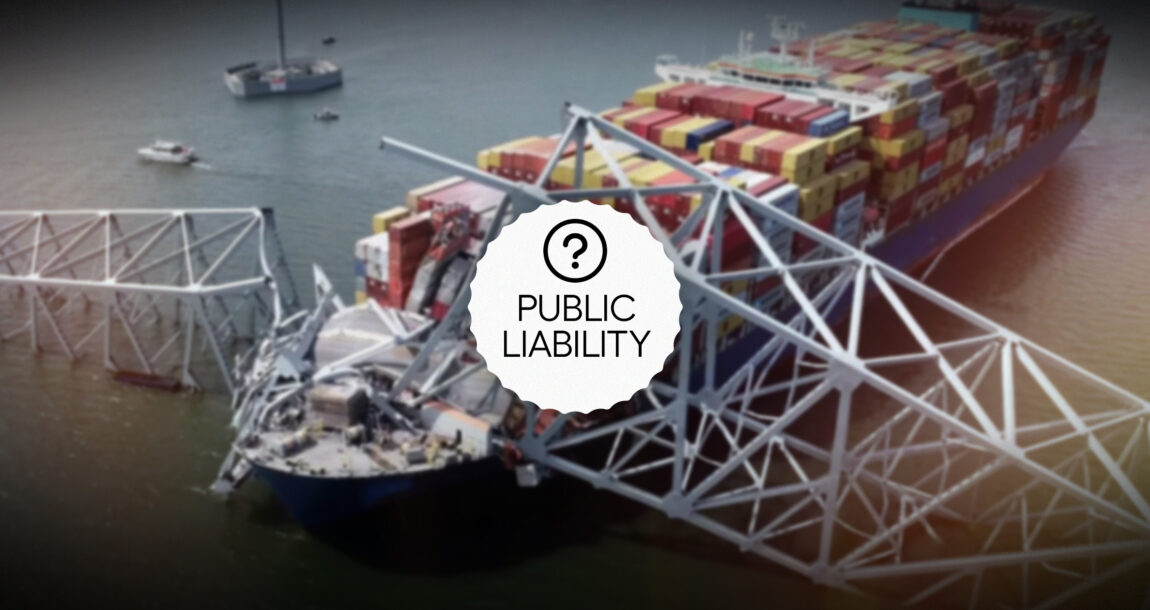The Francis Scott Key Bridge collapse: Questioning public liability

The collapse of the Francis Scott Key Bridge in Baltimore after being struck by a container ship on March 26 has reverberated through both the physical infrastructure and the financial landscape of the city.

Immediate costs and infrastructure repair
The bridge collapse requires immediate financial commitments to rescue operations and infrastructure repair. Emergency services - including search and rescue teams, medical personnel, and law enforcement - require significant funding to coordinate their efforts effectively. Furthermore, the cost of rebuilding the collapsed bridge and ensuring the structural integrity of adjacent infrastructure adds another layer of financial burden. These expenses strain municipal budgets and may require emergency funds or assistance from state or federal governments to address effectively.
Disruption to transportation networks
The collapse of a major bridge disrupts the flow of goods, services and commuters, affecting both local and regional economies. The ensuing traffic congestion diverts resources towards alternative routes, increasing transportation costs for businesses and consumers alike.
Delays in the delivery of goods and services ripple through supply chains, potentially leading to lost revenue and productivity. Moreover, the reliance on detours and alternate modes of transportation can exacerbate congestion and infrastructure strain in surrounding areas, compounding the economic impact of the collapse.
Legal and insurance claims
As the investigation into the cause of the bridge collapse unfolds, legal and insurance implications come to the forefront. Victims of the collapse - including injured individuals, families of the deceased, and businesses affected by the incident - may pursue legal action to seek compensation for damages.
Determining liability in cases of infrastructure failure involves complex legal considerations, including engineering assessments, regulatory compliance and contractual obligations. Insurance companies representing various stakeholders - including contractors, government agencies, and property owners - will play a crucial role in assessing and adjudicating claims, potentially leading to protracted legal battles and settlements.
Public liability and accountability
The collapse of the Francis Scott Key Bridge raises fundamental questions about public liability and accountability in infrastructure management. Government agencies responsible for the design, construction and maintenance of public infrastructure face scrutiny regarding their oversight and regulatory enforcement.
Concerns about deferred maintenance, inadequate inspections and budget constraints underscore the need for proactive risk management and investment in infrastructure resilience. Public trust in government institutions may erode in the wake of such incidents, impacting political discourse, policymaking and public-private partnerships essential for infrastructure development and maintenance.
Economic fallout and investor confidence
The financial fallout from the Francis Scott Key Bridge collapse extends beyond immediate costs and legal liabilities, affecting investor confidence and economic prospects. The perception of infrastructure risk can deter private investment in affected regions, dampening economic growth and development opportunities.
Businesses may reassess their location decisions and investment strategies in light of infrastructure vulnerabilities, potentially leading to capital flight or relocation. Moreover, credit rating agencies may downgrade municipal bonds and other financial instruments tied to the affected area, increasing borrowing costs and fiscal strain for local governments.
Long-term resilience and risk mitigation
In the aftermath of the Francis Scott Key Bridge collapse, policymakers, urban planners and infrastructure stakeholders must prioritize long-term resilience and risk mitigation strategies.
Investing in robust inspection and maintenance protocols, adopting advanced engineering technologies and incorporating climate resilience considerations into infrastructure design can help prevent future disasters. Moreover, enhancing emergency response capabilities and fostering community resilience through public education and preparedness initiatives are essential components of a comprehensive risk management strategy.
The financial implications of the Francis Scott Key Bridge collapse extend far beyond the immediate costs of rescue operations and infrastructure repair. As the city grapples with the aftermath of this tragedy, questions about public liability, legal accountability and long-term resilience come to the forefront.
Addressing these challenges requires a coordinated effort from government agencies, private sector stakeholders and the broader community to rebuild trust, enhance infrastructure resilience and safeguard against future disasters. Only through proactive risk management and investment can cities like Baltimore mitigate the economic impact of infrastructure failures and ensure the safety and well-being of their residents.
Neeraj Kaushik, principal consultant, is a product manager for the Infosys McCamish NGIN platform initiative at Infosys McCamish Systems. Contact him at [email protected].
© Entire contents copyright 2024 by InsuranceNewsNet.com Inc. All rights reserved. No part of this article may be reprinted without the expressed written consent from InsuranceNewsNet.com.
Neeraj Kaushik is principal consultant, Infosys McCamish, USA. Contact him at [email protected].




New rule simplifies Medicaid enrollment
Change Healthcare, medical providers still reeling from cyberattack
Advisor News
- Social Security retroactive payments go out to more than 1M
- What you need to know to find success with women investors
- Senator Gary Dahms criticizes Governor Walz's proposed insurance tax increase
- Social Security staff cuts could ‘significantly impact’ beneficiaries
- Building your business with generative AI
More Advisor NewsAnnuity News
Health/Employee Benefits News
- Evil stalks the land
- Idaho House approves Medicaid reform bill
- Trump makes it official: The American apology tour is over
- People, News & Notes: State treasurer advocates for increase in health plan premiums
- Accounts way to empower Americans with disabilities
More Health/Employee Benefits NewsLife Insurance News